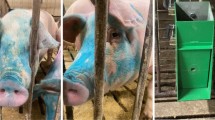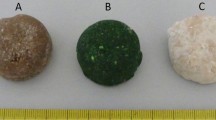Abstract
Studies were conducted to investigate the feasibility of marking the southwestern desert subterranean termite, Heterotermes aureus (Snyder), with rabbit immunoglobulin G (IgG) protein for mark–release–recapture (MRR) and mark–capture type studies. Qualitative laboratory studies were conducted to determine how long reagent-grade rabbit IgG is retained on or in H. aureus that were marked either externally with a topical spray, internally by feeding them a rabbit IgG-marked food source, or both internally and externally (double marked). Marked termites were detected by an anti-rabbit IgG enzyme-linked immunosorbent assay. Data indicated that the termites retained the mark for at least 35 days, regardless of the marking procedure. A second series of laboratory studies were conducted to determine how fast H. aureus acquire the mark after feeding on cardboard bait that was either sprayed or soaked in different formulations of rabbit IgG. The IgGs tested were a highly purified and costly reagent grade IgG at 5.0 mg/ml and a less pure and less costly technical grade rabbit IgG at 1.0 mg/ml. The results showed that termites acquired both marks equally well after exposure to the soaked cardboard treatment. The advantages and limitations of protein marking termites with rabbit IgG for MRR or mark–capture termite studies are discussed.


Similar content being viewed by others
References
Baker P.B. and Haverty M.I. 2007. Foraging populations and distances of the desert subterranean termite, Heterotermes aureus (Isoptera: Rhinotermitidae), associated with structures in southern Arizona. J. Econ. Entomol. 100: 1381–1390
Blackmer J.L., Hagler J.R., Simmons G.S. and Canas L.A. 2004. Comparative dispersal of Homalodisca coagulata and Homalodisca liturata (Homoptera: Cicadellidae). Environ. Entomol. 33: 88–99
Buczkowski G. and Bennett G. 2006. Dispersal central-place foraging in the polydomous odorous house ant, Tapinoma sessile as revealed by a protein marker. Insect. Soc. 53: 282–290
Buczkowski G., Wang C. and Bennett G. 2007. Immunomarking reveals food flow and feeding relationships in the eastern subterranean termite, Reticulitermes flavipes (Kollar). Environ. Entomol. 36: 173–182
DeGrandi-Hoffman G. and Hagler J.R. 2000. The flow of incoming nectar through a honey bee (Apis mellifera L.) colony as revealed by a protein marker. Insect Soc. 47: 302-306
Esenther G.R. 1980. Estimating the Size of Subterranean Termite Colonies by a Release–Recapture Technique. International Research Group on Wood Preservation Doc. No. IRG/WP/112: 4 pp
Evans T. 2001. Estimating relative decline in populations of subterranean termites (Isoptera: Rhinotermitidae) due to baiting. J. Econ. Entomol. 94: 1602–1609
Evans T. 2002. Tunnel specificity and forager movement in subterranean termites (Isoptera: Rhinotermitidae and Termitidae). Bull. Entomol. Res. 92: 193–201
Evans T. 2004. Comparing mark–capture and constant removal protocols for estimating forager population size of the subterranean termite Coptotermes lacteus (Isoptera: Rhinotermitidae). Bull. Entomol. Res. 94: 1–9
Evans T.A., Lenz M. and Gleeson P.V. 1998. Testing assumptions of mark–recapture protocols for estimating population size using Australian mound-building, subterranean termites. Ecol. Entomol. 23: 139–159
Forschler B. and Townsend M. 1996. Mark–release–recapture estimates of Reticulitermes spp. (Isoptera: Rhinotermitidae) colony foraging populations from Georgia, U.S.A. Environ. Entomol. 25: 952-962
Grace J.K. 1990. Mark–capture studies with Reticulitermes flavipes (Isoptera: Rhinotermitidae). Sociobiology 16: 297–303
Grace J.K. and Abdallay A. 1989. Evaluation of the dye marker Sudan red 7B with Reticulitermes flavipes (Isoptera: Rhinotermitidae). Sociobiology 15: 71–77
Haagsma K.A. and Rust M.K. 1993. Two marking dyes useful for monitoring field populations of Reticulitermes hesperus (Isoptera: Rhinotermitidae). Sociobiology 23: 155–165
Hagler J.R. and Jackson C.G. 2001. Methods for marking insects: Current techniques and future prospects. Annu. Rev. Entomol. 46: 511-543
Hagler J.R. and Naranjo S.E. 2004. A multiple ELISA for simultaneously monitoring intercrop movement and feeding activity of mass-released insect predators. Int. J. Pest Manag. 15: 321–339
Hagler J.R., Cohen A.C., Bradley-Dunlop D. and Enriquez F.J. 1992. New approach to mark insects for feeding and dispersal studies. Environ. Entomol. 21: 20–25
Hagler J.R, Jackson C.G., Henneberry T.J. and Gould J.R. 2002. Parasitoid mark–release–recapture techniques: II. Development and application of a protein marking technique for Eretmocerus spp., parasitoids of Bemisia argentifolii. Biocontrol Sci. Technol. 12: 661–675
Haverty M., Getty G., Copren K. and Lewis V. 2000. Size and dispersion of colonies of Reticulitermes spp. (Isoptera: Rhinotermitidae) in a wild land and a residual location in northern California. Environ. Entomol. 22: 241–249
Jones S.C. 1990. Delineation of Heterotermes aureus (Isoptera: Rhinotermitidae) foraging territories in a Sonoran Desert grassland. Environ. Entomol. 19: 1047–1054
Jones S.C., Trosset M. and Nutting W.L. 1987. Biotic and abiotic influences on foraging of Heterotermes aureus (Snyder) (Isoptera: Rhinotermitidae). Environ. Entomol. 16: 791-795
Jones V.P., Hagler J.R., Brunner J., Baker C. and Wilburn T. 2006. An inexpensive immunomarking technique for studying movement patterns of naturally occurring insect populations. Environ. Entomol. 35: 827-836
Oi F. 2000. Purple dye-marker for Reticulitermes spp. (Isoptera: Rhinotermitidae). Fla. Entomol. 83: 112–113
Peck S.L. and McQuate G.T. 2004. Ecological aspects of Bactrocera latifrons (Diptera: Tephritidae) on Maui, Hawaii: Movement and host preference. Environ. Entomol. 33: 1722-1731
Su N.-Y. 1994. Field evaluation of a hexaflumuron bait for population suppression of subterranean termites (Isoptera: Rhinotermitidae). J. Econ. Entomol. 87: 389–397
Su N.-Y., Scheffrahn R.H. and Ban P.M. 1988. Retention time and toxicity of a dye marker, Sudan Red 7B on the Formosan and eastern subterranean termite (Isoptera: Rhinotermitidae). J. Entomol. Sci. 23: 235–239
Su N.-Y., Ban P.M. and Scheffrahn R.H. 1991. Evaluation of twelve dye markers for population studies of the eastern and Formosan subterranean termite (Isoptera: Rhinotermitidae). Sociobiology 19: 349–362
Su N.-Y., Ban P.M. and Scheffrahn R.H. 1993. Foraging populations and territories of the eastern subterranean termite (Isoptera: Rhinotermitidae) in southeastern Florida. Environ. Entomol. 22: 1113–1117
Suárez M.E. and Thorne B.L. 2000. Rate, amount, and distribution pattern of alimentary fluid transfer via trophallaxis in three termites (Isoptera: Rhinotermitidae, Termopsidae). Ann. Entomol. Soc. Am. 93: 145–155
Thorne B.L., Russek-Cohen E., Forschler B.T., Breisch N.L. and Traniello J.F.A. 1996. Evaluation of mark–release–recapture methods for estimating forager population size of subterranean termite (Isoptera: Rhinotermitidae) colonies. Environ. Entomol. 25: 938-951
Acknowledgments
We would like to thank Dan Langhorst, Chrissie Pflipsen, Erik Stone, Heather Terry, Alex Yelich and Hao Yu for excellent technical support. The manuscript was improved by comments from Dawn Gouge (The University of Arizona), Michael Haverty (The University of California, Berkeley), Jean McLain (USDA-ARS, Maricopa, AZ), Steve Naranjo (USDA-ARS, Maricopa, AZ), and anonymous reviewers. This work was funded in part, by BASF.
Author information
Authors and Affiliations
Corresponding author
Rights and permissions
About this article
Cite this article
Hagler, J.R., Baker, P.B., Marchosky, R. et al. Methods to mark termites with protein for mark–release–recapture and mark–capture type studies. Insect. Soc. 56, 213–220 (2009). https://doi.org/10.1007/s00040-009-0010-8
Received:
Revised:
Accepted:
Published:
Issue Date:
DOI: https://doi.org/10.1007/s00040-009-0010-8




